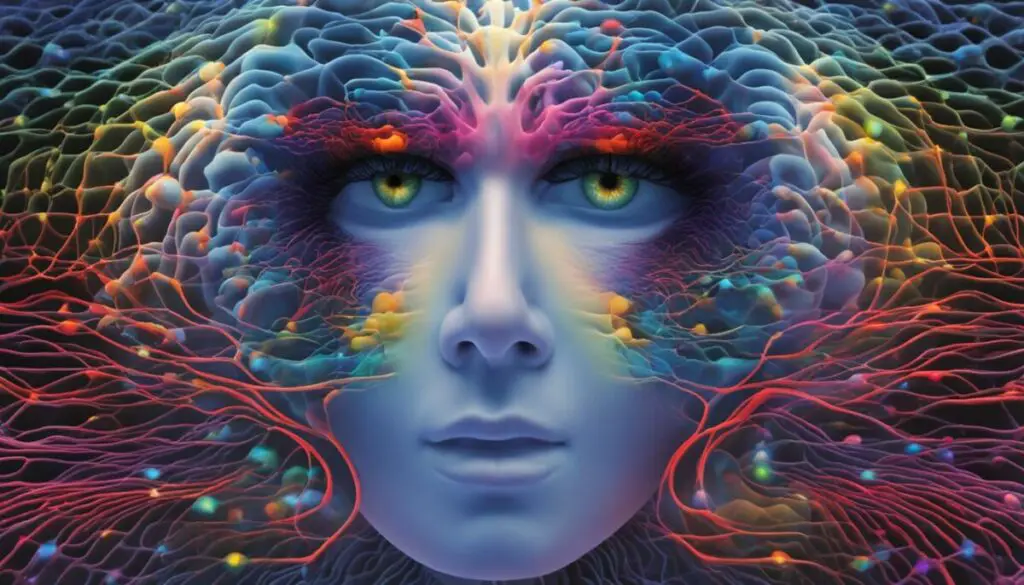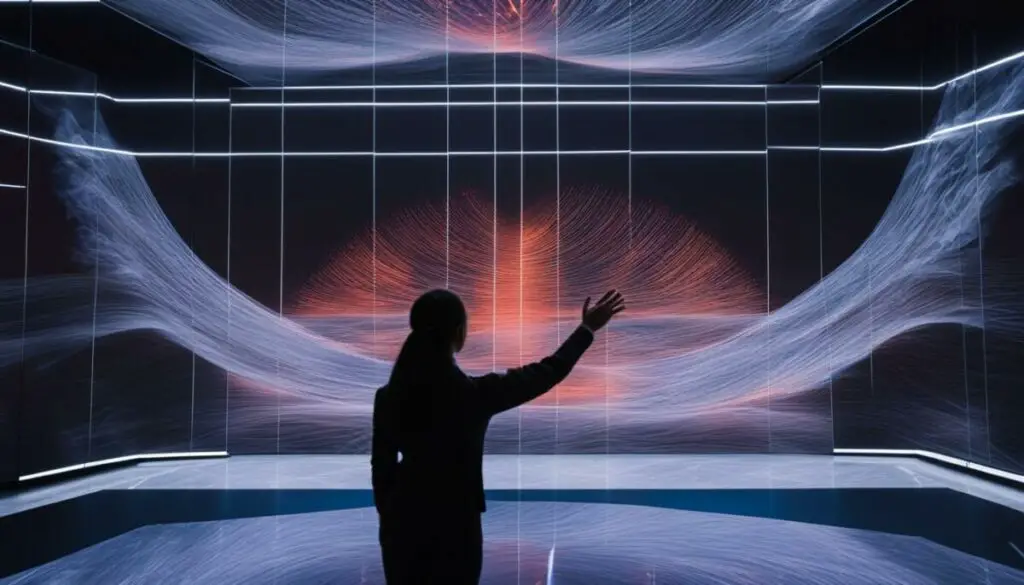Last Updated on 5 months by Francis
One of the fascinating aspects of mirror technology is its ability to block infrared waves, a characteristic that has significant implications in various fields. From surveillance to night vision, mirrors play a crucial role in enhancing image quality and capturing important details. But how exactly do mirrors achieve this? Let’s explore the science behind mirror technology and its interaction with infrared waves.
Contents
Key Takeaways:
- Mirrors can block infrared waves during the day using an IR cutoff filter known as a hot mirror.
- At night, the hot mirror filter is removed, allowing the reflection of infrared light and capturing detailed visible-near-infrared images.
- Fusion methods, such as multi-scale transform, sparse representation, neural network, subspace, and saliency methods, have been developed to enhance image quality by combining visible and infrared images.
- Mirror technology is crucial in surveillance systems, where it blocks infrared radiation during the day and captures both visible and near-infrared light at night.
- Improving image quality and accurately identifying objects in low-light environments are ongoing research goals in the field of mirror technology.
The Role of Mirror Technology in Surveillance

Mirror technology plays a crucial role in surveillance systems, particularly in blocking infrared radiation. By using mirrors, it is possible to prevent distortion or undesired artifacts in visible images during the day. The hot mirror filter, acting as an infrared (IR) cutoff filter, allows only visible light to pass through, ensuring clear and accurate imaging.
At night, when capturing images in low-light conditions, the hot mirror filter is removed to enable the detection of IR light. This allows surveillance cameras to capture both visible and near-infrared (NIR) light, resulting in sharper detail compared to visible images alone. Mirrors play a vital role in reflecting and directing IR light, ensuring the capture of clear images in different lighting conditions.
Mirror Properties and Infrared Reflection
Do mirrors reflect infrared light? Yes, mirrors have the property of reflecting IR light. The reflective surface of a mirror allows it to bounce back infrared waves, which are then detected and captured by the surveillance camera. This enables the camera to capture a comprehensive visible-NIR image, making it easier to identify objects and enhance overall image quality.
| Mirror Technology and Infrared Waves | Advantages |
|---|---|
| Blocking Infrared Radiation | Prevents distortion and artifacts in visible images during the day. |
| Reflection of Infrared Light | Enables the capture of both visible and NIR light, resulting in sharper detail. |
| Enhancement of Image Quality | Reflecting and directing IR light improves overall image clarity in different lighting conditions. |
Mirror technology, with its ability to block infrared radiation during the day and reflect IR light at night, plays a critical role in surveillance systems. By incorporating mirrors into the design, surveillance cameras can capture high-quality images in low-light environments, enhancing object identification and overall image clarity.
With advancements in mirror technology, the potential of surveillance systems continues to grow. By utilizing mirrors to block infrared radiation and reflect IR light, these systems can provide enhanced visibility and identification in various surveillance applications.
Challenges in Nighttime Image Capture

In the realm of nighttime image capture, there are several challenges that arise. One of these challenges is the issue of over-saturation and color distortion caused by the reflection of infrared (IR) light. This can result in distorted color and shape of the captured object, rendering the image less accurate and reliable. Adapting camera parameters and infrared LED lighting based on the subject’s distance and surrounding lighting conditions can be particularly challenging, especially in environments with significant lighting changes. Merely increasing camera sensitivity may not suffice in achieving optimal image quality.
Another challenge lies in the interaction between visible and strong IR lighting. This interaction can lead to color and saturation distortion, further compromising the quality of the captured image. Additionally, capturing images in low-light environments necessitates the blocking of thermal radiation, as it can interfere with the clarity and accuracy of the image. Overcoming these challenges requires the effective control of IR wave reflection and absorption.
To address these challenges, mirrors can serve as a valuable solution. By controlling the reflection and absorption of IR waves, mirrors can significantly improve image quality and enhance the identification of objects in low-light conditions. The surface properties of mirrors play a crucial role in infrared reflection. Understanding and optimizing these properties can further enhance the performance of mirrors in blocking IR waves and improving nighttime image capture.
Table: Mirror Surface Properties and Infrared Reflection
| Mirror Surface Properties | Infrared Reflection |
|---|---|
| Smooth and polished surface | Minimizes IR wave scattering and improves reflection |
| Specially coated surface | Enhances IR reflectivity and reduces absorption |
| Metallic or dielectric layers | Provides selective reflection of specific IR wavelengths |
By analyzing and optimizing mirror surface properties, it becomes possible to minimize scattering, maximize reflection, and reduce absorption of IR waves. This, in turn, results in clearer and more accurate nighttime images. The development of advanced mirror technology holds great promise for overcoming the challenges associated with nighttime image capture, ultimately enhancing object identification and improving the performance of surveillance systems in low-light environments.
Advancements in Image Fusion Methods
Mirror technology and infrared waves have paved the way for significant advancements in image fusion methods. These methods, including multi-scale transform, sparse representation, neural network, subspace, and saliency methods, have revolutionized the field of image processing by effectively combining visible and infrared images.
Multi-scale transform techniques involve dividing input images into layers of multiple levels, allowing for the extraction of intricate details and features. Sparse representation methods utilize mathematical algorithms to represent images as a combination of a few essential components, reducing noise and enhancing image quality.
Neural networks have also made a notable impact in image fusion. These networks analyze and process multiple input images, leveraging their complex architecture to extract relevant information and generate a fused image that retains both visible and infrared details. Subspace methods employ linear algebra techniques to represent images in low-dimensional spaces, facilitating efficient fusion of visible and infrared images. Lastly, saliency methods emphasize the most important features of an image, enhancing the clarity and quality of fused images.
Advancements in Image Fusion Methods:
- Multi-scale transform techniques
- Sparse representation methods
- Neural networks
- Subspace methods
- Saliency methods
“Image fusion techniques utilizing mirror technology and infrared waves have opened up new possibilities in various applications, including surveillance systems, night vision, and medical imaging. These advancements enable clearer and more detailed imaging in low-light and complex environments, providing valuable information for decision-making and analysis.”
By harnessing the power of mirror surfaces and infrared reflection, these image fusion methods have far-reaching implications in fields such as surveillance, remote sensing, and medical imaging. They empower us to capture high-quality images in challenging conditions and extract valuable insights from visual data.
| Fusion Method | Advantages |
|---|---|
| Multi-scale transform | Enhanced detail extraction |
| Sparse representation | Noise reduction, improved image quality |
| Neural networks | Efficient fusion of visible and IR images |
| Subspace methods | Optimal representation in low-dimensional spaces |
| Saliency methods | Highlighting important image features |
As mirror technology continues to evolve and image fusion methods advance, we can expect further breakthroughs in the field of image processing. These advancements will not only enhance the capabilities of surveillance systems and medical imaging but also contribute to improved decision-making in various industries.
Understanding the Neural Mechanisms of Action Observation

Action observation is a fascinating cognitive process that allows us to understand and imitate the actions of others. It involves the activation of the mirror neuron system (MNS) and theory of mind (ToM) networks in our brains. The MNS plays a crucial role in recognizing and understanding observed actions, while the ToM network helps us infer the intentions and mental states of others. These complex brain networks work in tandem, enabling us to make sense of the actions we observe.
Research using techniques such as electroencephalography (EEG) and functional near-infrared spectroscopy (fNIRS) has shed light on the temporal-spatial dynamics during action observation. A study combining EEG and fNIRS measurements revealed that the involvement of the MNS and ToM/mentalizing network varies depending on the clarity of the observed action’s intention. The analysis of brain activation patterns provides valuable insights into the neural mechanisms underlying action observation and intention understanding.
| Mirror Neuron System (MNS) | Theory of Mind (ToM) Network |
|---|---|
| The MNS is responsible for action recognition and understanding | The ToM network helps infer the intentions and mental states of others |
| Activated by observed hand-object interactions | Enables understanding of others’ actions and intentions |
| Crucial for imitating and learning new skills | Facilitates social interaction and empathy |
The insights gained from studying action observation and the underlying neural mechanisms have implications for various fields, including human-machine interaction. Machines that can understand and recognize human actions and intentions can facilitate more effective and intuitive interactions. The integration of mirror technology with neural signals, such as EEG and fNIRS, holds promise for improving intention recognition in human-machine interfaces. This has exciting applications in healthcare, robotics, and virtual reality, where accurate perception and interpretation of human actions are essential.
By delving deeper into the neural mechanisms of action observation, we can unlock new possibilities for human-machine interaction and gain a better understanding of the complex processes that drive our interactions with the world around us.
Temporal-Spatial Dynamics during Action Observation

During action observation, the human brain displays intricate temporal-spatial dynamics involving the mirror neuron system (MNS) and the theory of mind (ToM) network. To better understand these dynamics, a study utilized combined EEG and fNIRS measurements to investigate the neural processes underlying action observation. Participants were tasked with observing three action scenarios: grasping a cup with the intention of drinking, grasping a cup with the intention of moving it, and touching a cup with an unclear intention.
The results of the study revealed that both the MNS and the ToM/mentalizing network were dynamically engaged during action observation. The extent of activation of these networks was influenced by the clarity of the observed action’s intention. By analyzing EEG and fNIRS data, researchers gained insights into the underlying neural mechanisms involved in action observation and intention understanding.
These findings contribute to our understanding of the complex processes behind action observation and highlight the significance of the MNS and ToM networks in decoding the intentions of others. Additionally, this research emphasizes the potential of EEG and fNIRS as valuable tools for studying neural dynamics in real-time during action observation.
Table: EEG and fNIRS Results for Action Observation
| Action Task | EEG Signals | fNIRS Signals |
|---|---|---|
| Grasping a cup with the intention of drinking | Increased alpha and mu band activity in the MNS | Increased oxygenated hemoglobin levels in the ToM network |
| Grasping a cup with the intention of moving it | Decreased alpha and mu band activity in the MNS | Increased deoxygenated hemoglobin levels in the ToM network |
| Touching a cup with an unclear intention | Fluctuating alpha and mu band activity in the MNS | Varied oxygenated and deoxygenated hemoglobin levels in the ToM network |
These findings highlight the dynamic involvement of the mirror neuron system (MNS) and the theory of mind (ToM) network during action observation. The clarity of an observed action’s intention influences the extent of engagement of these networks. EEG and fNIRS data provide valuable insights into the neural mechanisms underlying action observation and intention understanding.
Action Observation and Neural Processes: Insights from EEG and fNIRS

Action observation is a fascinating cognitive process that allows us to understand and imitate the actions of others. By observing someone perform a specific action, our brains activate the mirror neuron system (MNS) and the theory of mind (ToM) network, enabling us to recognize and comprehend the intentions behind those actions. To unravel the neural mechanisms underlying action observation, researchers have turned to advanced technologies such as electroencephalography (EEG) and functional near-infrared spectroscopy (fNIRS).
A recent study utilized a combined EEG and fNIRS approach to investigate the temporal-spatial dynamics during action observation. Participants were asked to observe different action tasks, such as grasping a cup with the intention of drinking, moving a cup with the intention of relocation, and touching a cup with an unclear intention. The results revealed the dynamic involvement of both the MNS and the ToM/mentalizing network, with the extent of engagement depending on the clarity of the observed action’s intention.
Continued advancements in this field have led to the development of a feature classification method that allows for the identification and classification of the neural processes underlying action observation. By constructing complex brain networks using EEG and fNIRS data, researchers have successfully achieved a classification accuracy of 72.7% for different action observation tasks. This demonstrates the feasibility of decoding the underlying neural processes and gaining valuable insights into action understanding and intention recognition.
| EEG and fNIRS Methods | Classification Accuracy |
|---|---|
| Action Observation | 72.7% |
These findings have significant implications for the field of human-machine interaction. Machines equipped with the ability to understand and recognize human actions and intentions can enhance the effectiveness and safety of various applications, including healthcare, robotics, and virtual reality. By leveraging mirror technology, which improves the accuracy of action perception, machines can utilize neural signals obtained from EEG and fNIRS measurements to monitor and interpret human intention recognition processes, facilitating seamless interaction between humans and machines.
Insights into Action Observation
- EEG and fNIRS provide valuable insights into the neural mechanisms underlying action observation.
- Action observation activates the mirror neuron system (MNS) and the theory of mind (ToM) network.
- Temporal-spatial dynamics during action observation vary based on the clarity of observed action intentions.
- EEG and fNIRS data can be used to construct complex brain networks, enabling the classification of neural processes.
- Action observation research has implications for improving human-machine interaction in various fields.
“Through EEG and fNIRS measurements, we can gain a deeper understanding of the complex neural processes involved in action observation. This knowledge can be harnessed to enhance human-machine interaction and drive advancements in various domains.”
Implications for Human-Machine Interaction

Action observation and intention understanding have significant implications for human-machine interaction. Machines need to be able to recognize and interpret human actions and intentions in order to facilitate effective and seamless interaction. Neural signals, such as EEG and fNIRS, provide valuable insights into human cognitive processes and can serve as feedback signals to machines, enabling them to monitor and adapt to the human’s process of intention recognition.
It is important for machines to accurately perceive and understand human actions in order to enhance the safety, efficiency, and overall user experience in various fields, including healthcare, robotics, and virtual reality.
By leveraging mirror technology, machines can improve their ability to accurately perceive and understand human actions. Mirrors play a crucial role in action observation by facilitating the activation of the mirror neuron system and theory of mind networks in the human brain. By understanding the underlying neural mechanisms of action observation using EEG and fNIRS, machines can better interpret and respond to human actions and intentions.
Ultimately, the implications of action observation and intention understanding for human-machine interaction are far-reaching. By harnessing the power of neural signals and mirror technology, we can create more intuitive and seamless interfaces between humans and machines, leading to enhanced collaboration and improved performance in various domains.
The Importance of Climate Science

Climate science plays a critical role in understanding and predicting changes in weather patterns and global warming. Scientists have observed a significant increase in extreme weather events, such as mega-storms, droughts, and wildfires. These changes have been attributed to human-induced climate change, primarily through the burning of fossil fuels. The scientific consensus is that global climate change is occurring, and it is essential to address this issue to minimize its impact on the planet and human society.
Exploring Weather Patterns
Understanding weather patterns is a crucial aspect of climate science. By analyzing historical data and conducting experiments, scientists can identify trends, patterns, and predictors of different weather phenomena. This knowledge enables us to anticipate and prepare for extreme weather events and make informed decisions regarding disaster management, agriculture, and infrastructure development. Climate science equips us with the tools to mitigate the risks associated with climate change and protect both the environment and human well-being.
Combatting Global Warming
Global warming is one of the most pressing challenges facing our planet today. It is caused by the accumulation of greenhouse gases in the Earth’s atmosphere, primarily carbon dioxide from human activities. Climate science plays a vital role in understanding the mechanisms behind global warming, including the impact of various factors such as deforestation, industrial emissions, and transportation. By studying these factors, scientists can develop effective strategies to reduce greenhouse gas emissions, promote renewable energy sources, and implement sustainable practices. The insights gained from climate science are crucial for developing policies and initiatives that can help combat global warming and preserve the planet for future generations.
Decoding the Weather Machine
The “Decoding the Weather Machine” documentary takes us on a global journey to unravel the complexities of our planet’s climate system. By understanding the inner workings of the climate machine, we gain valuable insights into the causes and effects of weather patterns. Through the dedicated efforts of scientists worldwide, we can decode the mechanisms behind our changing climate and make informed decisions to address the challenges we face.
Climate science plays a crucial role in predicting and interpreting weather patterns, including extreme events such as hurricanes, droughts, and heatwaves. By studying the climate system, scientists can identify the factors influencing these patterns and gain a deeper understanding of how our actions contribute to climate change. This knowledge empowers us to take proactive steps towards reducing our impact on the environment and mitigating the consequences of global warming.
The documentary showcases the groundbreaking research and technological advancements that enable us to study and decode the weather machine. Through the use of advanced sensors, satellite imagery, and climate models, scientists are able to gather data and simulate complex climate processes. By analyzing this data, they can uncover patterns and trends that provide critical insights into future climate scenarios.
Understanding the climate machine is not just a scientific pursuit; it has real-world implications for our daily lives. By decoding the weather machine, we can better prepare for extreme weather events, develop strategies for sustainable agriculture and resource management, and ensure the resilience of our communities in the face of a changing climate. It is through our collective efforts and continued commitment to climate science that we can navigate the challenges ahead and secure a sustainable future for generations to come.
Conclusion
In conclusion, mirror technology has proven to be a valuable tool in various applications, including surveillance systems and action observation. Mirrors can effectively block infrared waves, improving image quality and allowing for clearer visibility in both day and night conditions. By reflecting and directing infrared light, mirrors help capture detailed images and enhance object identification.
In the field of action observation, mirror technology facilitates the activation of the mirror neuron system and theory of mind networks, allowing for better understanding of others’ actions and intentions. This understanding is crucial for advancements in human-machine interaction, as machines can utilize neural signals to recognize and respond to human actions more accurately. Mirror technology enhances the safety and efficiency of interactions in fields such as healthcare, robotics, and virtual reality.
Beyond the realm of mirror technology, understanding and decoding the weather machine is vital for addressing the challenges posed by climate change. Climate science provides insights into weather patterns and global warming, enabling us to predict and mitigate the impact of extreme weather events. By combining scientific research, technological advancements, and environmental awareness, we can work towards a sustainable future and protect our planet for generations to come.
FAQ
Can mirrors block infrared waves?
Yes, mirrors can block infrared (IR) waves during the day using an IR cutoff filter known as a hot mirror. This filter allows only visible light to pass through, blocking IR light. However, at night, the hot mirror filter is removed to enable the detection of IR light.
What is the role of mirror technology in surveillance?
In surveillance systems, mirrors are used to block infrared radiation during the day to prevent distortion or undesired artifacts in visible images. The hot mirror filter acts as an IR cutoff filter, allowing only visible light to pass through. At night, when capturing images in low-light conditions, the hot mirror filter is removed to enable the detection of IR light.
What are the challenges in nighttime image capture?
Capturing clear images at night presents several challenges. IR light reflections can cause over-saturation and affect the color and shape of the captured object. Adapting camera parameters and IR LED lighting according to the distance of the subject and surrounding light can be difficult, especially in environments with severe lighting changes. Capturing images in low-light environments requires appropriate exposure times and the blocking of thermal radiation.
What are the advancements in image fusion methods?
Advancements in image fusion methods such as multi-scale transform, sparse representation, neural network, subspace, and saliency methods have greatly improved image quality in surveillance systems. These methods combine visible and IR images effectively, enhancing detail and reducing noise.
How does action observation work?
Action observation involves understanding and imitating the form and motion of an action by observing others. The mirror neuron system (MNS) and theory of mind (ToM) networks are activated during action observation and help in understanding others’ actions and intentions.
What are the temporal-spatial dynamics during action observation?
A study using combined EEG and fNIRS measurement investigated the temporal-spatial dynamics during action observation. The extent of engagement of the MNS and ToM networks during action observation depends on the clarity of the observed action’s intention.
How are neural processes during action observation classified?
Neural processes during action observation can be classified using a feature classification method. Complex brain networks constructed from EEG and fNIRS data are analyzed, and features from both modalities are fused to improve classification accuracy.
What are the implications for human-machine interaction?
Action observation and intention understanding are crucial in human-machine interaction scenarios. By understanding the neural processes underlying action observation using mirror technology, machines can improve their ability to perceive and understand human actions accurately.
What is the importance of climate science?
Climate science plays a critical role in understanding and predicting changes in weather patterns and global warming. It helps us understand the impact of human-induced climate change and allows us to take steps towards minimizing its consequences.
What is the “Decoding the Weather Machine” documentary about?
The “Decoding the Weather Machine” documentary explores the complex interactions and processes that drive our planet’s climate system. It highlights the efforts of scientists to decode the mechanisms behind our changing climate and emphasizes the importance of understanding and addressing climate change.









